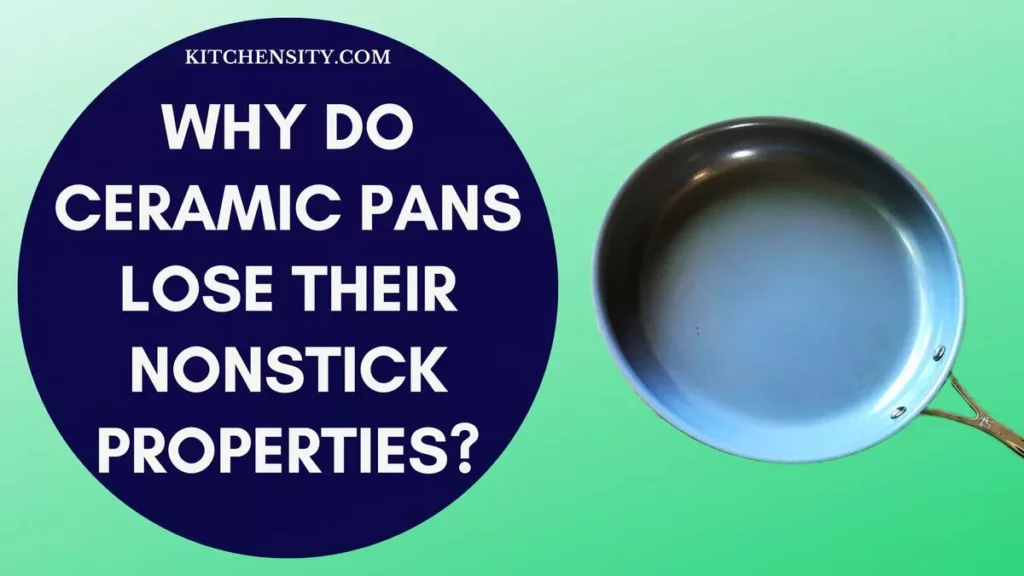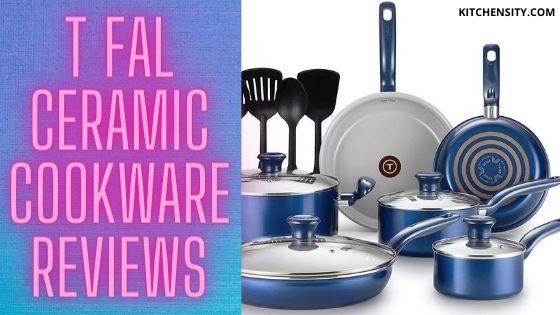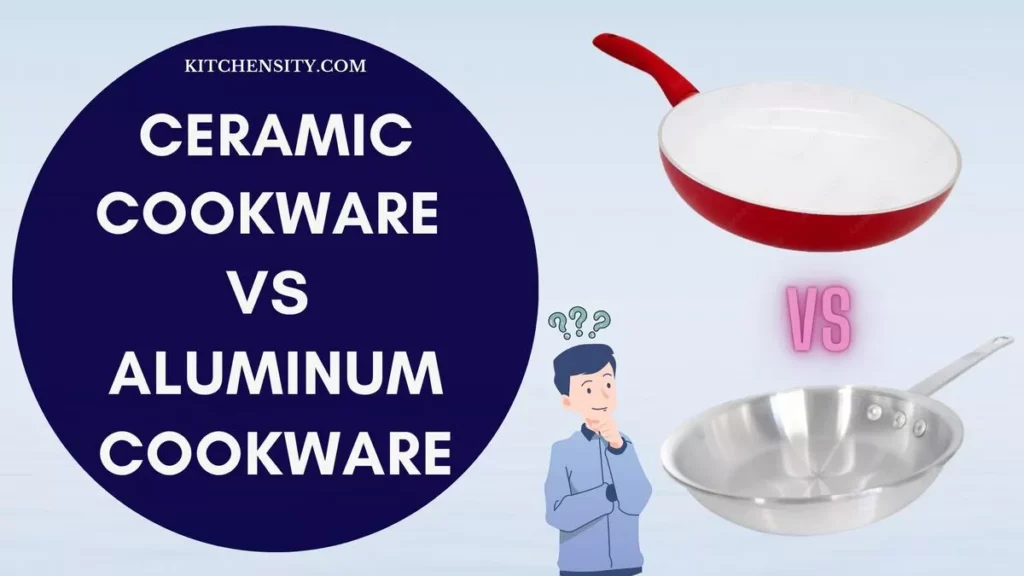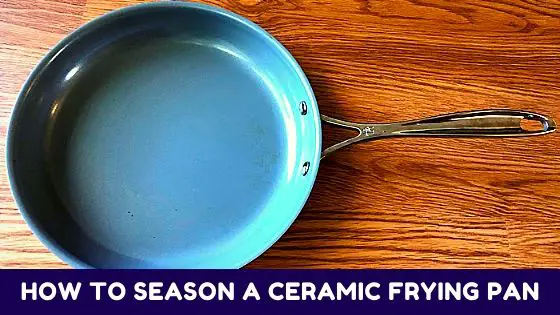Ceramic pans have gained popularity in recent years as a healthier alternative to traditional nonstick cookware.
They offer a naturally derived nonstick surface that allows for cooking with less oil and provides easy food release.
However, over time, ceramic pans may lose their nonstick properties, leading to frustration and decreased performance.
In this article, we will explore the reasons behind the loss of nonstick on ceramic pans and discuss ways to prevent it.

Table of Contents
- 1 Why Do Ceramic Pans Lose Their Nonstick Properties?
- 2 Understanding Ceramic Pans
- 3 The Nonstick Coating On Ceramic Pans
- 4 The Reasons Behind the Loss of Nonstick Properties
- 5 How To Prevent Nonstick Loss?
- 6 Alternative Solutions for Nonstick Cooking
- 7 How Do You Restore A Ceramic Non-Stick Pan?
- 8 How Long Do Ceramic Non-Stick Pans Last?
- 9 Why Do Eggs Stick To Ceramic Pan?
- 10 Conclusion
- 11 FAQs
- 11.1 Can I Use Metal Utensils On A Ceramic Pan Without Damaging The Nonstick Coating?
- 11.2 Can I Use My Ceramic Pan In The Oven?
- 11.3 How Long Do Ceramic Pans Typically Last Before The Nonstick Coating Wears Off?
- 11.4 Can I Use Abrasive Cleaning Agents To Remove Tough Stains From My Ceramic Pan?
- 11.5 Is It Necessary To Season A Ceramic Pan?
Why Do Ceramic Pans Lose Their Nonstick Properties?
Ceramic pans can lose their nonstick properties due to factors such as high heat and overheating, the use of metal utensils that scratch the surface, abrasive cleaning methods that damage the coating, and wear and tear over time. These factors can lead to the degradation of the ceramic coating, resulting in diminished nonstick performance.
Also Read – How To Season A Ceramic Frying Pan
Understanding Ceramic Pans
- Ceramic pans are cookware made from a metal base, usually aluminum, with a ceramic nonstick coating applied to the cooking surface.
- This coating is typically made from inorganic materials like silica and sand, which are hardened and bonded to the metal.
- Ceramic pans have gained popularity due to their nonstick properties and perceived safety compared to traditional nonstick coatings that may contain chemicals like PFOA or PTFE.
The Nonstick Coating On Ceramic Pans
- The nonstick coating on ceramic pans provides a smooth and slick surface that prevents food from sticking during cooking.
- It allows for easy flipping and turning of delicate foods like eggs and pancakes.
- The ceramic coating is also resistant to staining and can be more durable than traditional nonstick coatings, depending on its quality and care.
Also Read – T Fal Ceramic Cookware Reviews
The Reasons Behind the Loss of Nonstick Properties
- High Heat And Overheating:
- Exposing ceramic pans to high temperatures beyond their recommended limits can cause the nonstick coating to deteriorate.
- High heat can damage the molecular structure of the ceramic coating, making it less effective over time.
- It is essential to follow the manufacturer’s instructions regarding heat limits.
- Use Of Metal Utensils:
- Scratching the surface of ceramic pans with metal utensils can lead to the loss of nonstick properties.
- Metal utensils can create tiny abrasions on the coating, causing food to stick and the coating to degrade.
- It is best to use non-metal utensils like silicone, wood, or plastic to preserve the nonstick surface.
- Abrasive Cleaning Methods:
- Rough cleaning techniques, such as scrubbing with abrasive sponges or using harsh cleaning agents, can damage the ceramic coating.
- It is recommended to use gentle cleaning methods, such as mild dish soap and a soft sponge, to maintain the nonstick properties of the pan.
- Wear And Tear Over Time: With regular use, the nonstick coating on ceramic pans may naturally wear down. Over time, the coating can become thinner and less effective. This gradual deterioration can lead to food sticking and the need for re-seasoning or replacement of the pan.
Also Read – Best 100 Percent Ceramic Nonstick Cookware Set Reviews
How To Prevent Nonstick Loss?
To extend the lifespan of the nonstick properties on ceramic pans, consider the following preventive measures:
- Proper Heat Management: Avoid exposing ceramic pans to high heat beyond their recommended limits. Use medium or low heat settings whenever possible. Preheating the pan gradually can help distribute heat evenly and prevent overheating.
- Utensil Selection And Usage: Opt for non-metal utensils like silicone, wood, or plastic to avoid scratching the ceramic coating. These utensils are gentle on the surface and minimize the risk of damage.
- Gentle Cleaning Techniques: Clean ceramic pans with mild dish soap, warm water, and a soft sponge. Avoid abrasive scrubbers or cleaning agents that can harm the nonstick coating. If there are stubborn residues, soak the pan in warm, soapy water before gently scrubbing.
- Regular Maintenance And Care:
- To prolong the nonstick properties, it is crucial to maintain and care for ceramic pans properly.
- Avoid stacking heavy objects on top of the pans to prevent scratching.
- Store them in a dry place to avoid moisture buildup.
- Follow any specific care instructions provided by the manufacturer.
Also Read – Hard-Anodized Vs Ceramic Cookware Comparison
Alternative Solutions for Nonstick Cooking
If the nonstick properties of your ceramic pan have significantly diminished, there are alternative solutions you can try:
- Seasoning The Pan:
- Seasoning involves applying a thin layer of oil to the pan and heating it at a low temperature.
- This process can help fill in any minor imperfections on the ceramic coating and enhance its nonstick capabilities.
- Follow the manufacturer’s instructions or search for specific seasoning techniques for ceramic pans.
- Using Oil Or Butter For Cooking: If the nonstick surface of the pan is compromised, using a small amount of oil or butter can prevent food from sticking. While it may add some calories to your dish, it can provide an effective temporary nonstick solution.
- Exploring Other Nonstick Cookware Options:
- If you find that your ceramic pan no longer meets your nonstick needs, consider exploring other nonstick cookware options.
- There are various materials available, such as stainless steel with nonstick coatings or cast iron pans seasoned to create a natural nonstick surface.
Also Read – How To Get Sticky Residue Off Non-Stick Pans?
How Do You Restore A Ceramic Non-Stick Pan?
To restore a ceramic non-stick pan, you can follow these steps:
- Clean the Pan: Start by thoroughly cleaning the pan with warm water and mild dish soap. Use a soft sponge or cloth to remove any food residue or stains.
- Remove Stubborn Stains: If there are stubborn stains that won’t come off with regular cleaning, you can try a mixture of baking soda and water. Make a paste and apply it to the stained areas. Let it sit for a few minutes, then gently scrub it with a soft sponge or cloth.
- Rinse and Dry: After cleaning, rinse the pan with warm water to remove any residue. Make sure to dry it completely using a soft towel or air-drying it.
- Season the Pan:
- Seasoning a ceramic non-stick pan can help restore its non-stick properties.
- Apply a small amount of oil to the surface of the pan and spread it evenly using a paper towel.
- Heat the pan on low to medium heat for a few minutes until the oil starts to smoke.
- Allow the pan to cool down, then wipe off any excess oil with a paper towel.
- Avoid High Heat: To prevent further damage to the non-stick coating, avoid using high heat settings when cooking with the pan. Stick to medium or low heat to ensure the longevity of the non-stick properties.
- Use Appropriate Utensils: Always use non-metal utensils, such as silicone, wood, or plastic, when cooking with a ceramic non-stick pan. Metal utensils can scratch the surface and compromise the non-stick coating.
- Gentle Cleaning: Going forward, use gentle cleaning methods for the pan. Avoid abrasive sponges or harsh cleaning agents that can damage the coating. Stick to mild dish soap and a soft sponge or cloth.
By following these steps, you can help restore the non-stick properties of your ceramic pan and ensure its longevity.
Remember to take proper care of the pan to maintain its non-stick capabilities over time.
Also Read – How To Fix Scratched Non-Stick Pans?
How Long Do Ceramic Non-Stick Pans Last?
The lifespan of ceramic non-stick pans can vary depending on several factors, including the quality of the pan, frequency of use, and how well it is maintained. On average, a well-cared-for ceramic non-stick pan can last anywhere from 1 to 5 years.
- It’s important to note that the non-stick properties of ceramic pans may gradually diminish over time.
- The ceramic coating can wear down with repeated use, exposure to high heat, and the use of abrasive cleaning methods or utensils.
- As a result, food may start sticking to the surface, and the pan may not perform as effectively as it did when it was new.
To extend the lifespan of a ceramic non-stick pan, it’s recommended to follow the manufacturer’s instructions for proper use and care.
This typically includes avoiding high heat, using non-metal utensils, gentle cleaning with mild dish soap, and avoiding stacking heavy objects on top of the pan.
- Regular maintenance, such as seasoning the pan periodically and avoiding extreme temperature changes, can also help prolong its non-stick capabilities.
- However, even with proper care, it’s normal for the ceramic coating to gradually wear off over time.
If you notice a significant deterioration in the non-stick properties of your ceramic pan, it may be time to consider replacing it.
It’s important to assess the condition of the pan and make an informed decision based on its performance and any visible signs of wear and tear.
Also Read – How To Clean Burnt Calphalon Pans?
Why Do Eggs Stick To Ceramic Pan?
If your eggs are sticking to your ceramic pan, there could be several reasons for it. Here are a few possible explanations:
- Insufficient Preheating: It’s important to preheat your ceramic pan properly before adding the eggs. If the pan isn’t adequately preheated, the eggs are more likely to stick. Allow the pan to heat up over medium-low heat for a few minutes before adding any ingredients.
- Inadequate Oil Or Butter: Eggs tend to stick, especially if you’re using a dry pan. Make sure to add a sufficient amount of oil or butter to the pan before cracking the eggs. The fat creates a barrier between the eggs and the pan’s surface, reducing the chances of sticking.
- High Heat: Cooking eggs over high heat can cause them to stick to the pan. It’s best to use medium to medium-low heat when cooking eggs in a ceramic pan. High heat can quickly evaporate the moisture from the eggs, making them more likely to stick.
- Use Of Metal Utensils: If you’re using metal utensils to cook or flip your eggs, they can scratch the ceramic coating, leading to sticking. Opt for non-metal utensils like silicone, wood, or plastic to protect the non-stick surface of your pan.
- Worn-Out Non-Stick Coating: Over time, the non-stick coating on ceramic pans can wear off, making them less effective. If you’ve had your pan for a long time or have used abrasive cleaning methods, the non-stick properties may have diminished. In such cases, eggs are more likely to stick to the pan.
To prevent eggs from sticking to your ceramic pan, ensure proper preheating, use enough oil or butter, and cook them over medium to medium-low heat.
Also, avoid using metal utensils and assess the condition of your pan’s non-stick coating.
If the coating is significantly worn or damaged, it may be time to consider replacing the pan.
Also Read – How To Remove The Non-Stick Coating From Cookware?
Conclusion
Ceramic pans are popular for their nonstick properties, but over time, they may lose their effectiveness due to factors like high heat, use of metal utensils, abrasive cleaning methods, and wear and tear.
By practicing proper heat management, using non-metal utensils, employing gentle cleaning techniques, and maintaining the pan regularly, you can extend the lifespan of the nonstick coating.
If necessary, alternative solutions like seasoning the pan or exploring other nonstick cookware options can help restore your cooking experience.
Also Read – Does Enamel Cast Iron Chip?
FAQs
-
Can I Use Metal Utensils On A Ceramic Pan Without Damaging The Nonstick Coating?
It is best to avoid using metal utensils on ceramic pans as they can scratch the nonstick coating. Opt for non-metal utensils like silicone, wood, or plastic to preserve the nonstick surface.
-
Can I Use My Ceramic Pan In The Oven?
Most ceramic pans are oven-safe up to a certain temperature. Check the manufacturer’s instructions to determine the oven-safe temperature range for your specific pan.
-
How Long Do Ceramic Pans Typically Last Before The Nonstick Coating Wears Off?
The lifespan of ceramic pans can vary depending on the quality of the pan and how well it is cared for. With proper maintenance, a ceramic pan can last several years before the nonstick coating starts to deteriorate.
-
Can I Use Abrasive Cleaning Agents To Remove Tough Stains From My Ceramic Pan?
It is not recommended to use abrasive cleaning agents on ceramic pans as they can damage the nonstick coating. Instead, try soaking the pan in warm, soapy water and using a soft sponge to remove tough stains.
-
Is It Necessary To Season A Ceramic Pan?
While seasoning is not typically required for ceramic pans, it can help enhance the nonstick capabilities if the coating has become less effective. Follow the manufacturer’s instructions or search for specific seasoning techniques for ceramic pans.
Katrina Smith is a seasoned expert with over 25 years of experience in all things related to cooking and the kitchen. As an avid cook and kitchen enthusiast, she is passionate about sharing her knowledge and expertise on cookware, kitchen appliances, kitchen tips, and kitchen staples.
Through her articles and reviews, Katrina aims to inspire and help others improve their cooking skills, experiment with different ingredients, and invest in quality cookware and appliances.




![Best 100% Ceramic Nonstick Cookware Set [2024] 6 Best 100 Percent Ceramic Nonstick Cookware Set](https://www.kitchensity.com/wp-content/uploads/2019/09/Best-100-Percent-Ceramic-Nonstick-Cookware-Set.jpg)